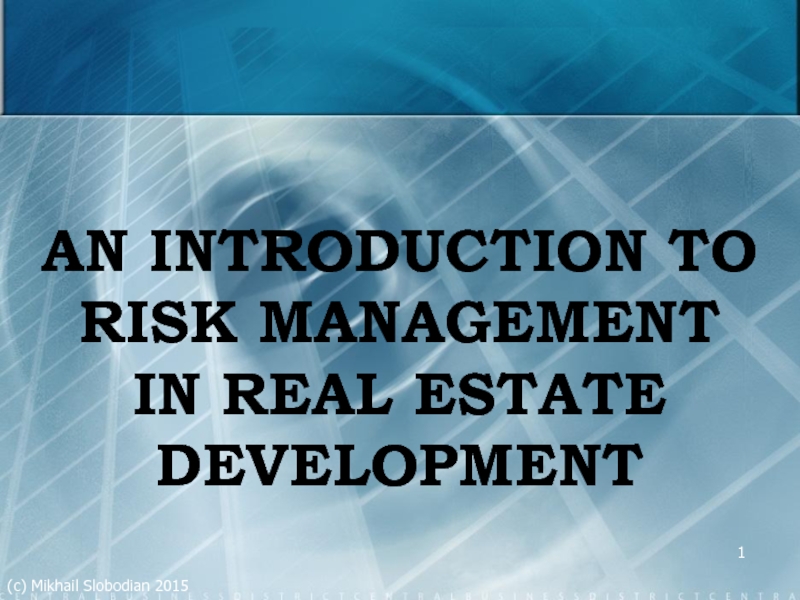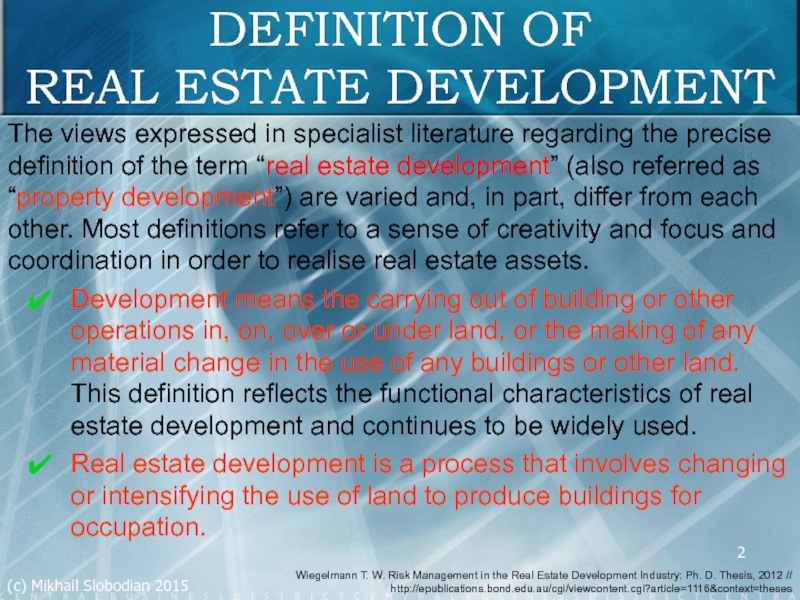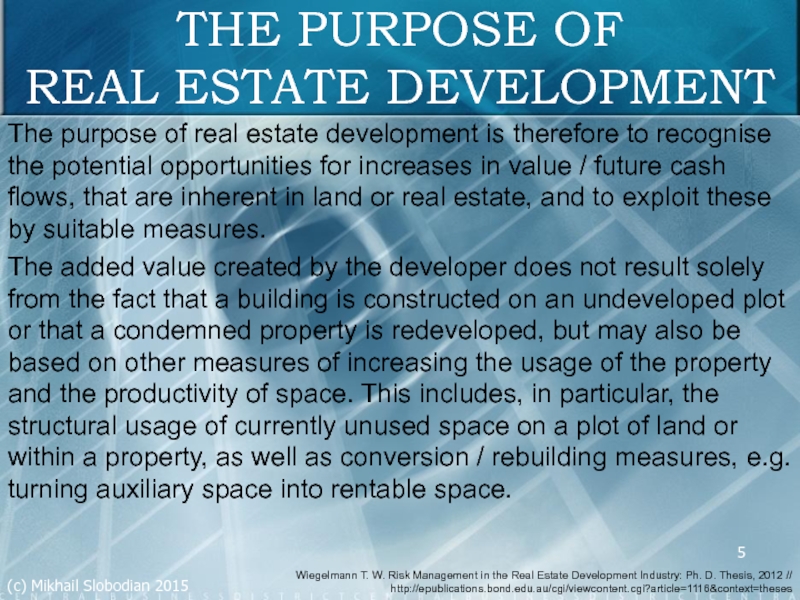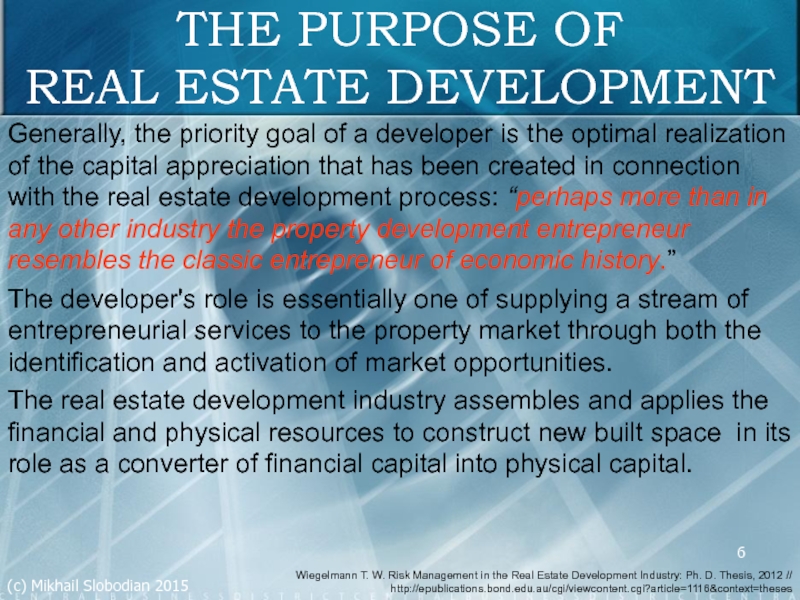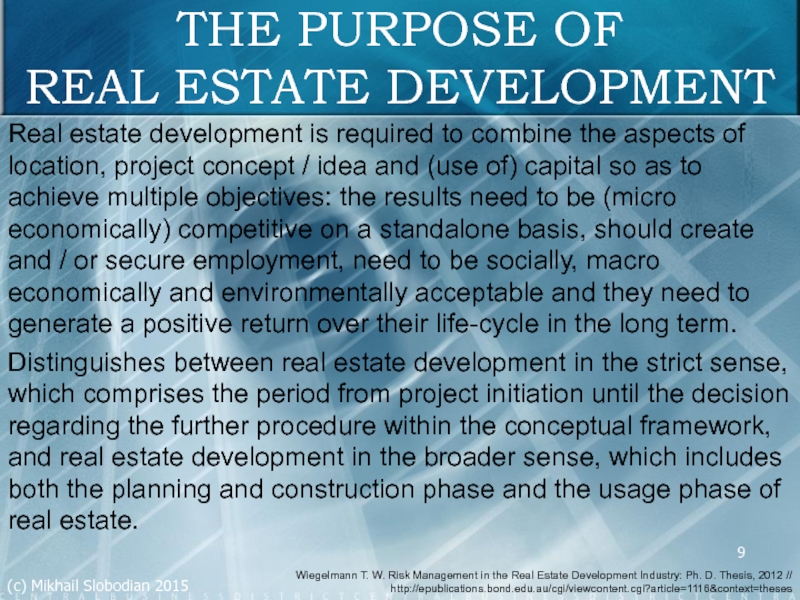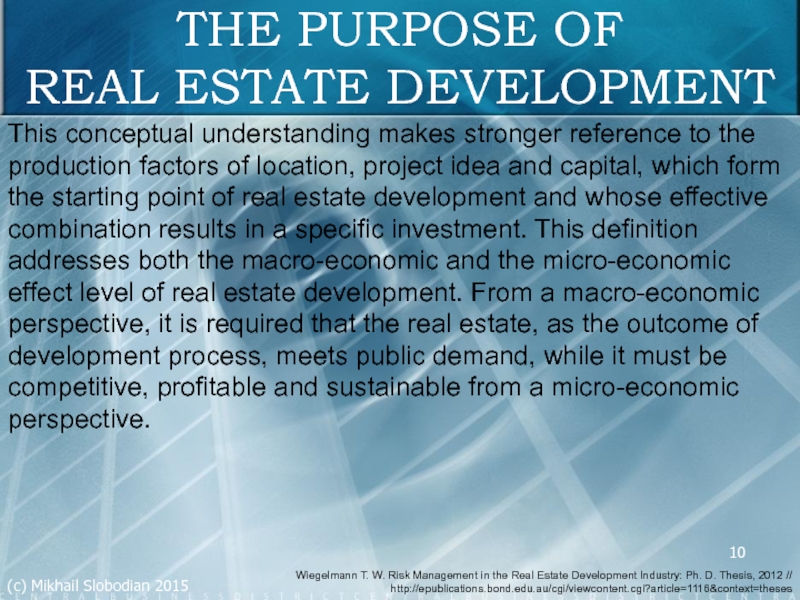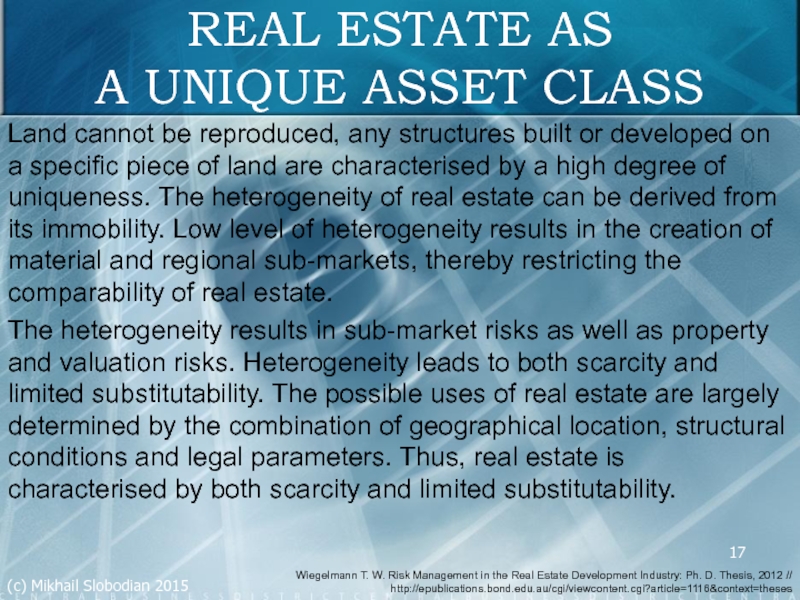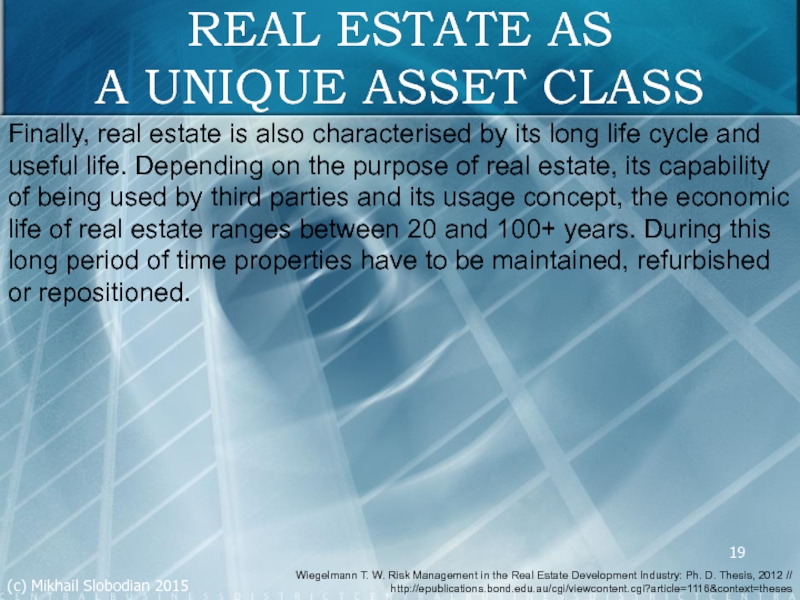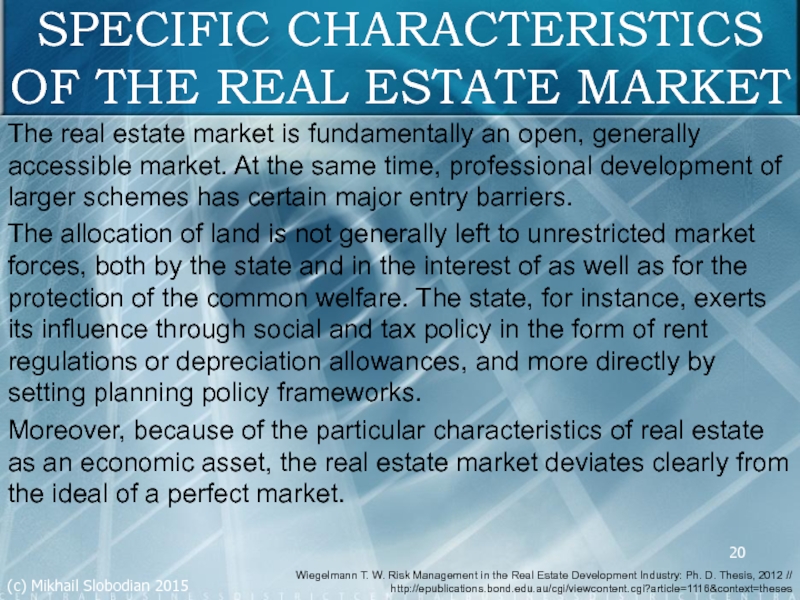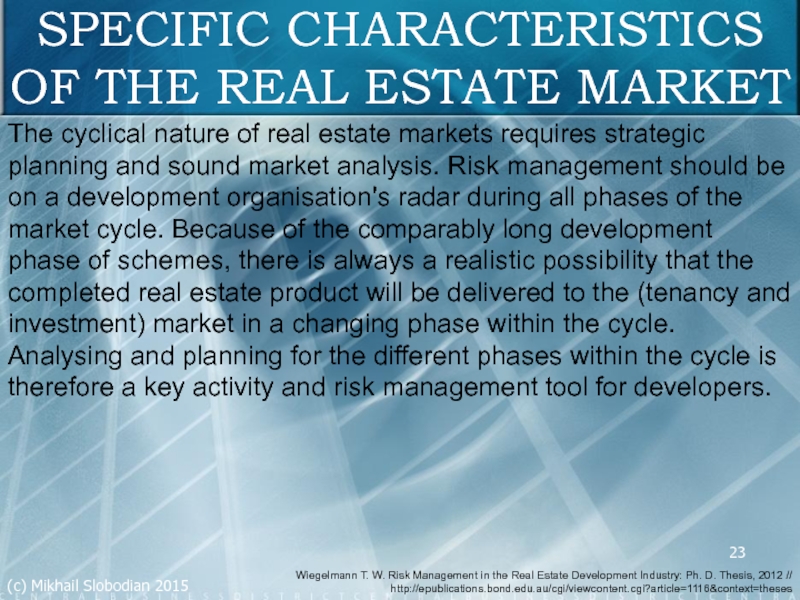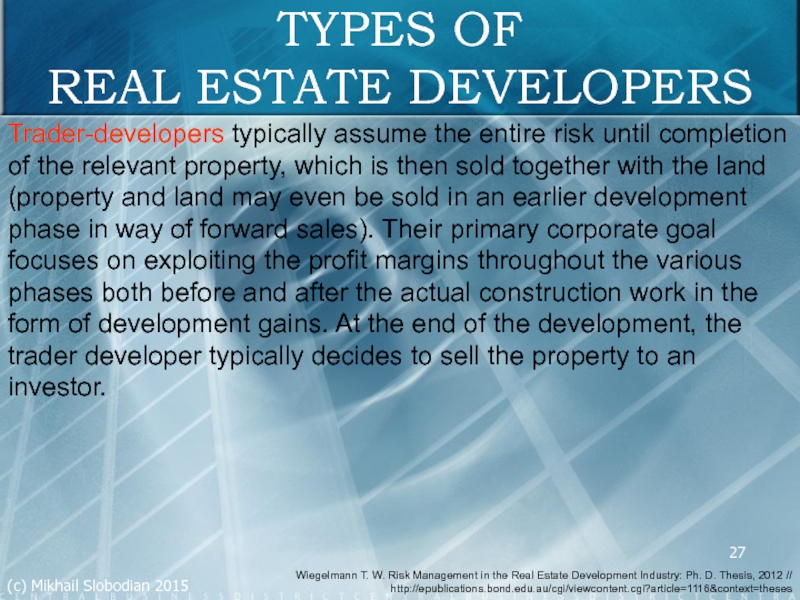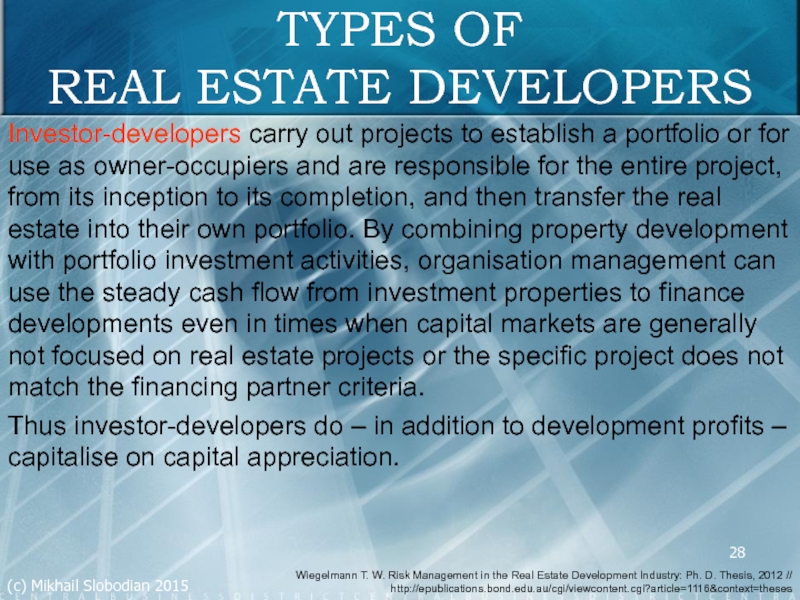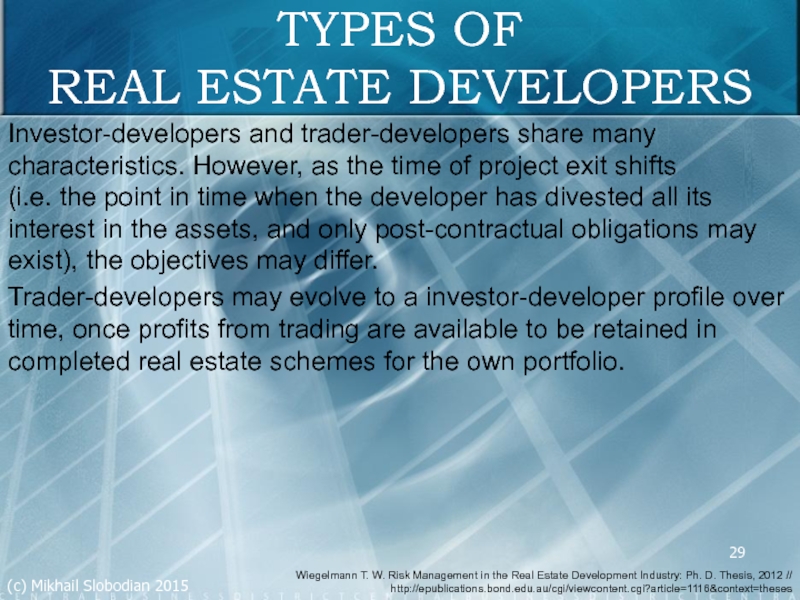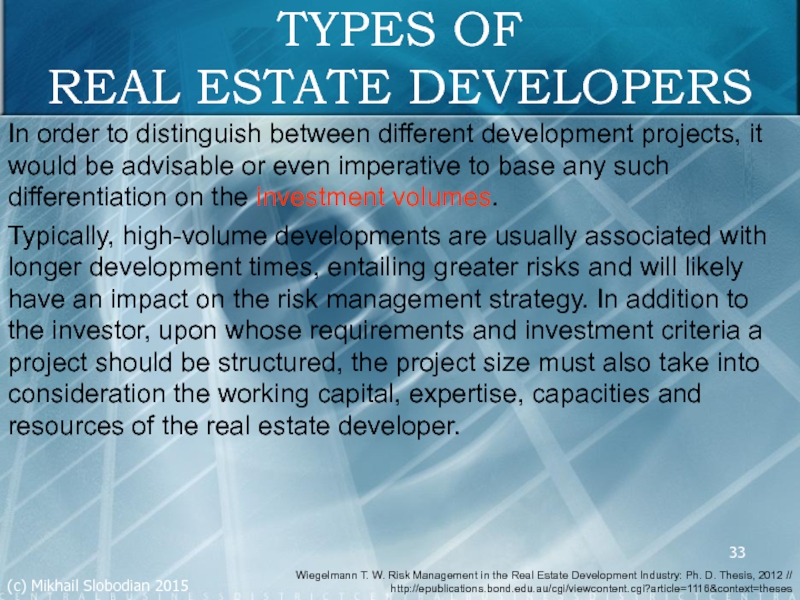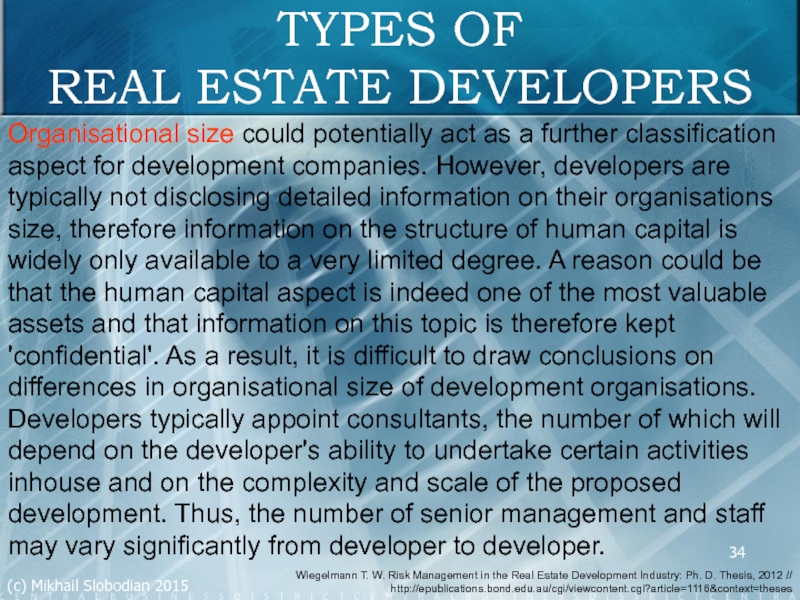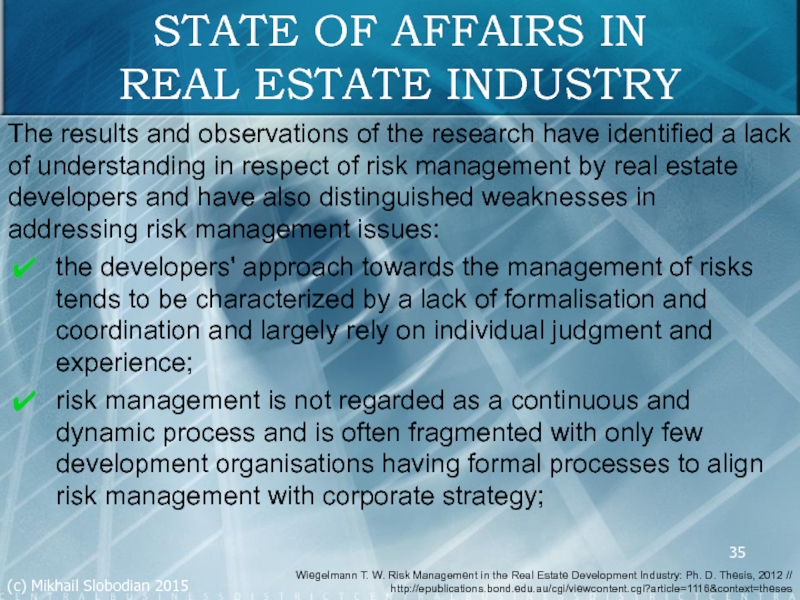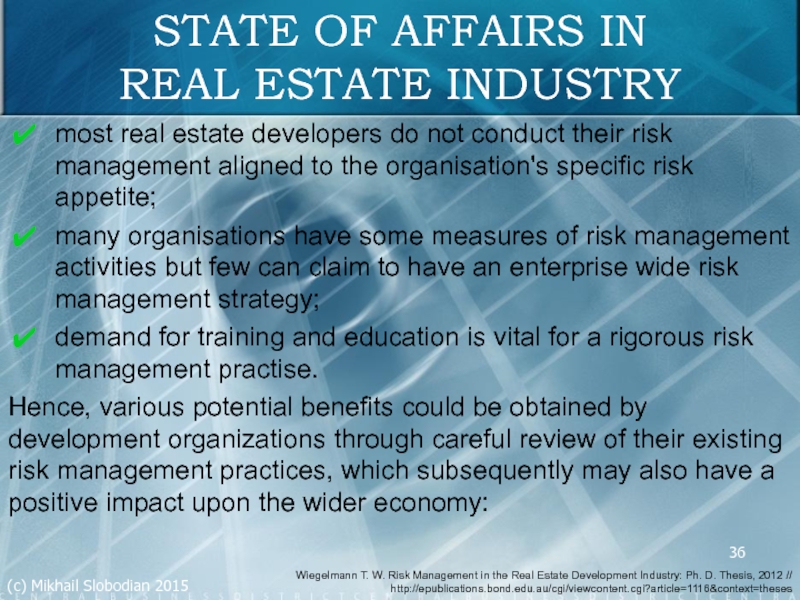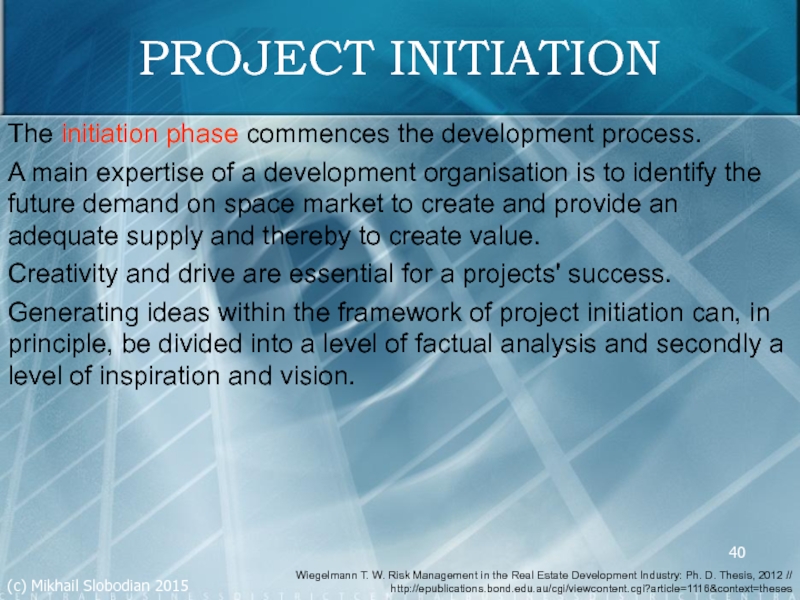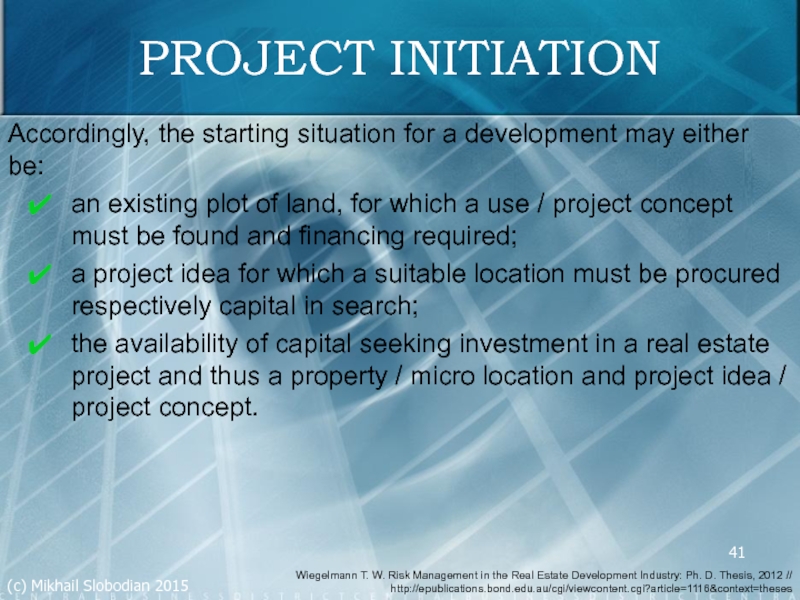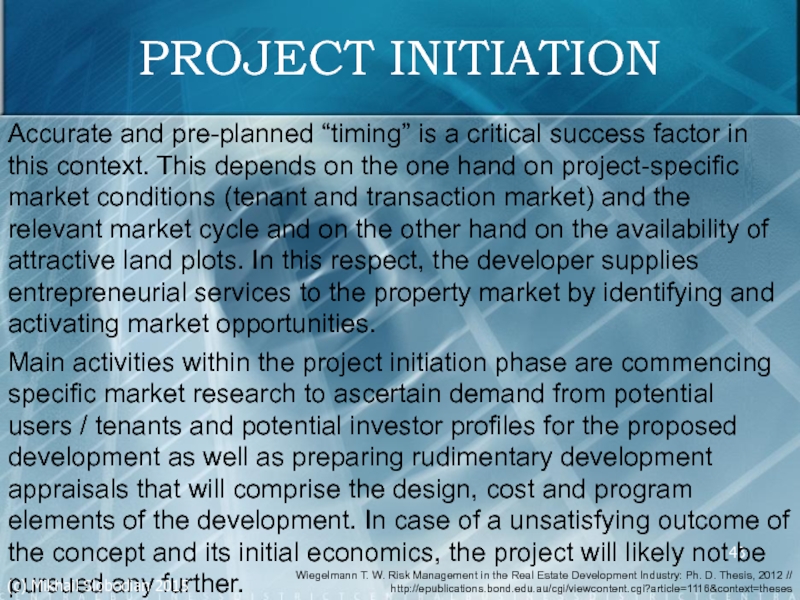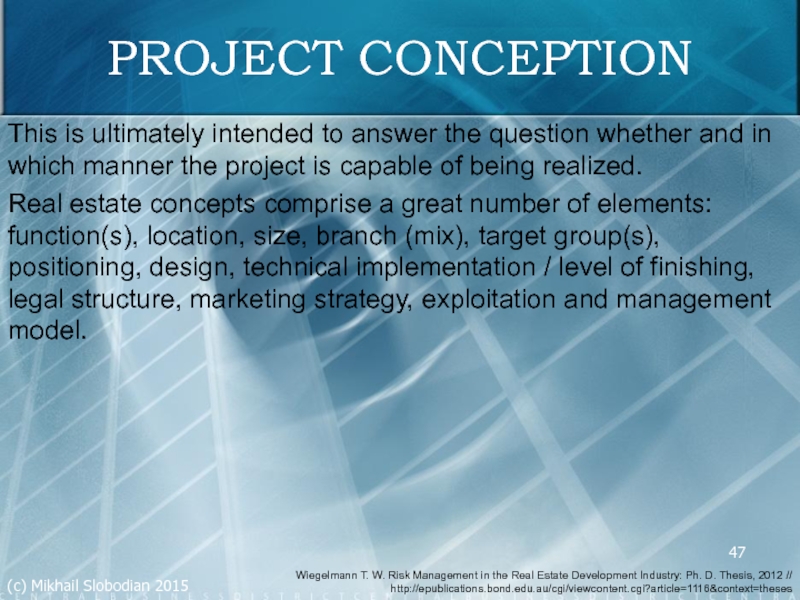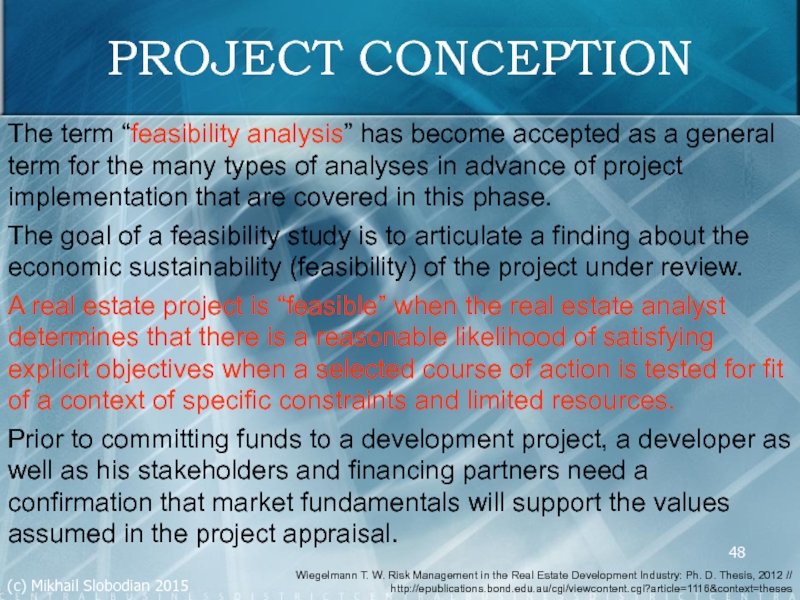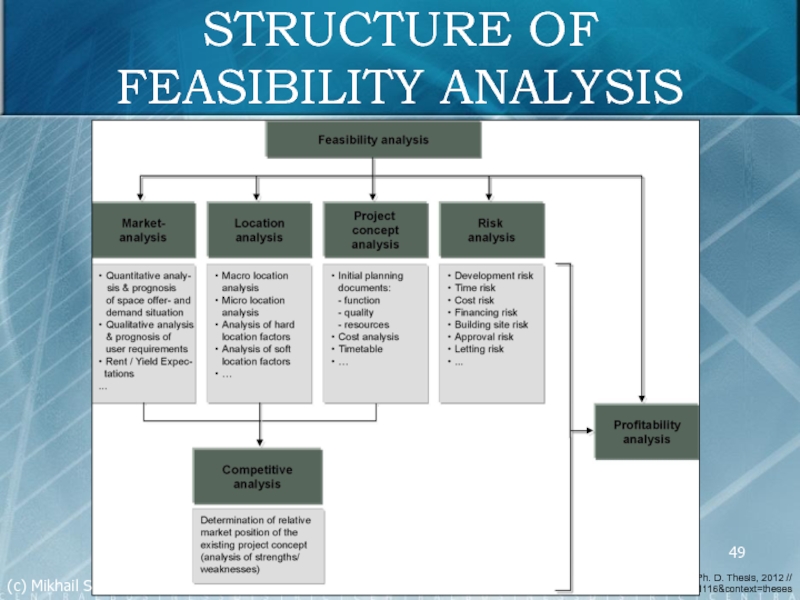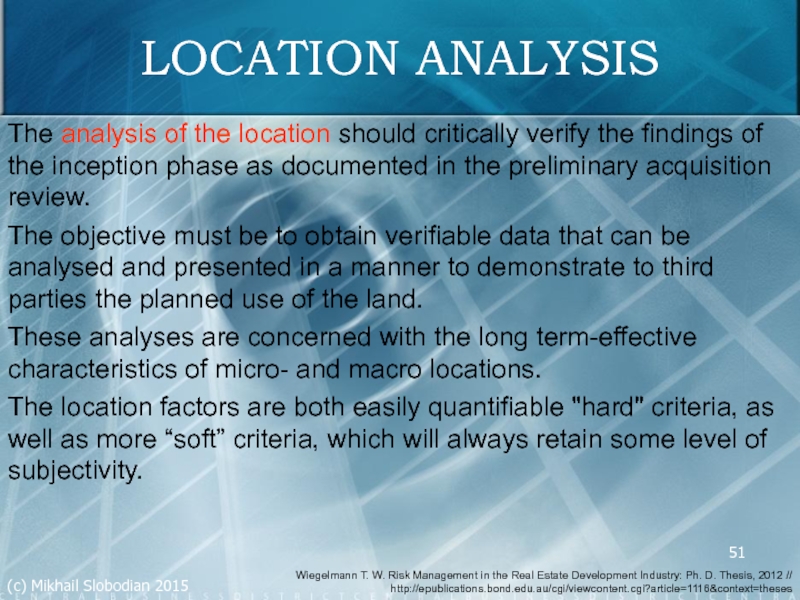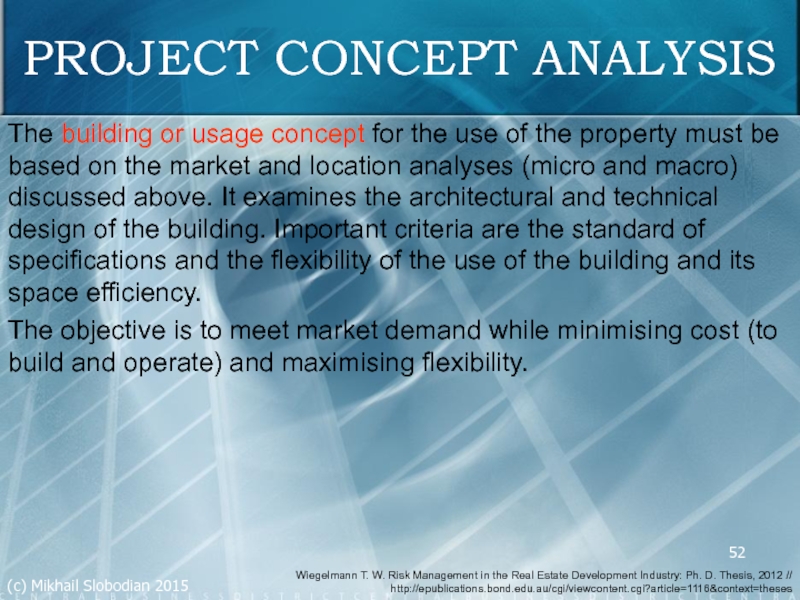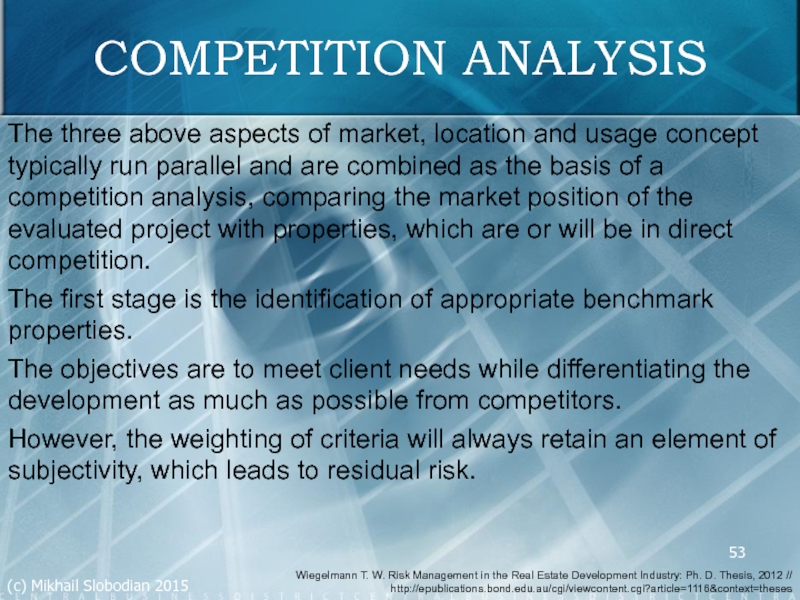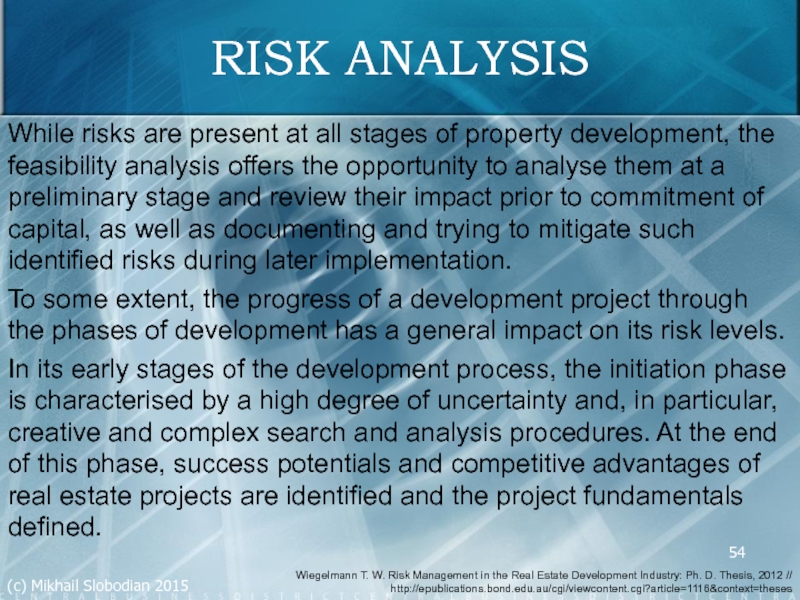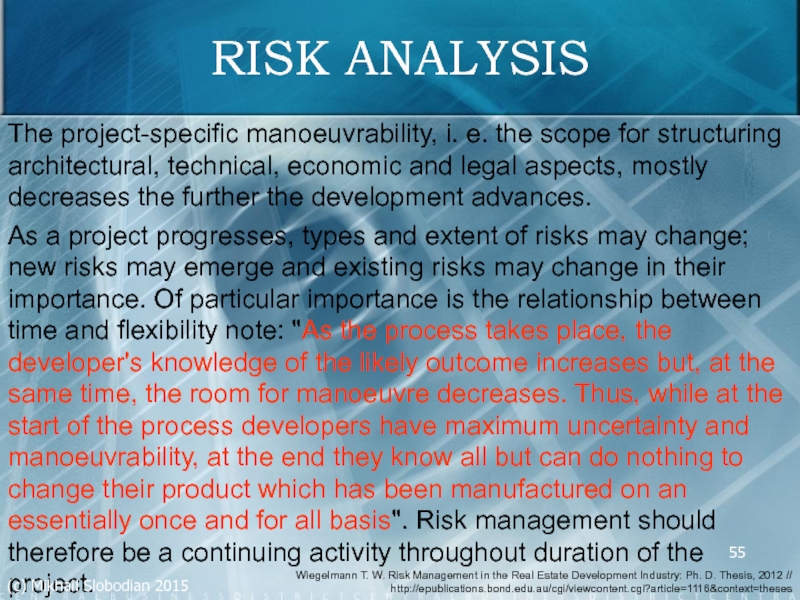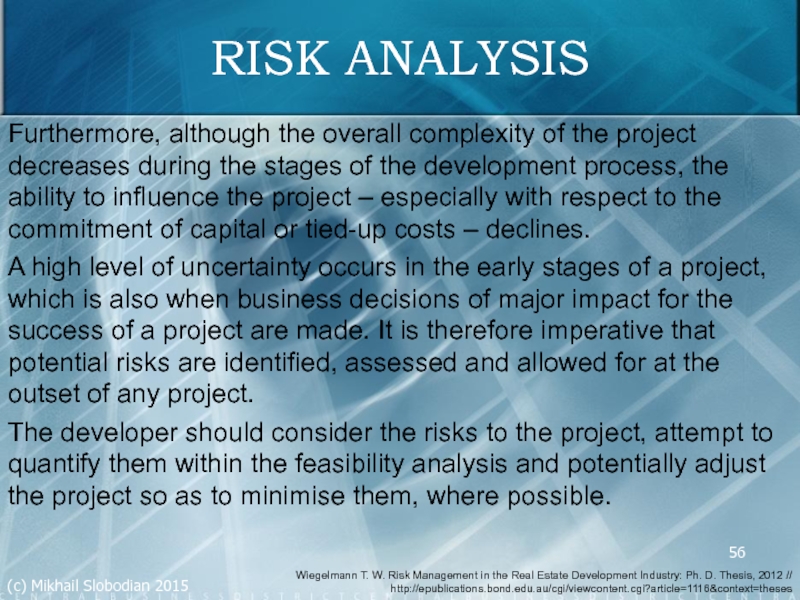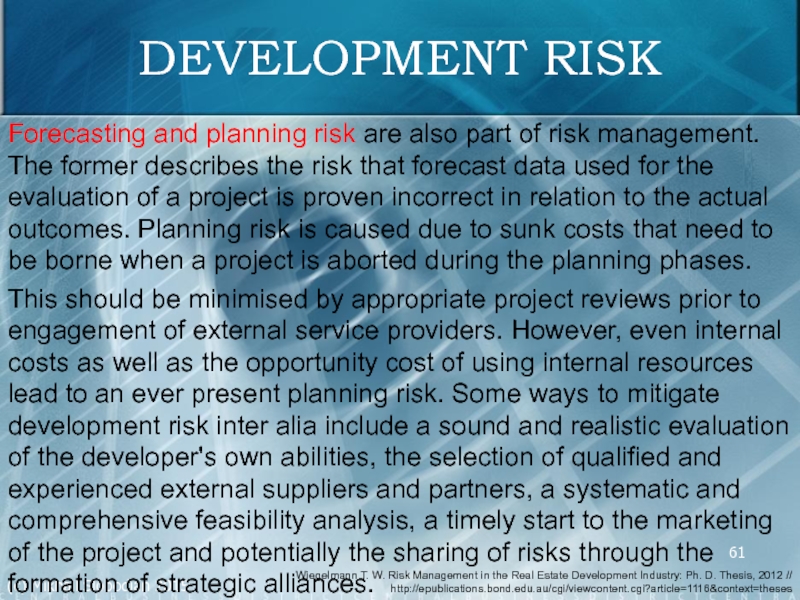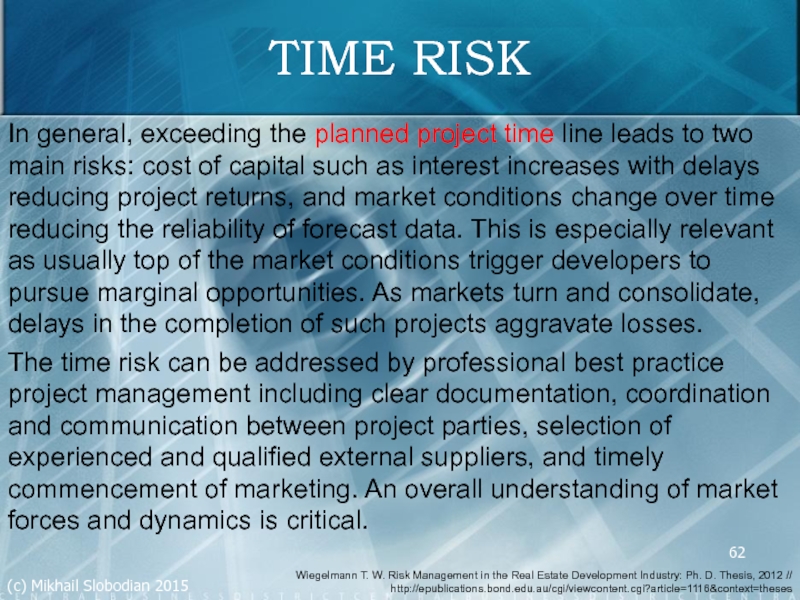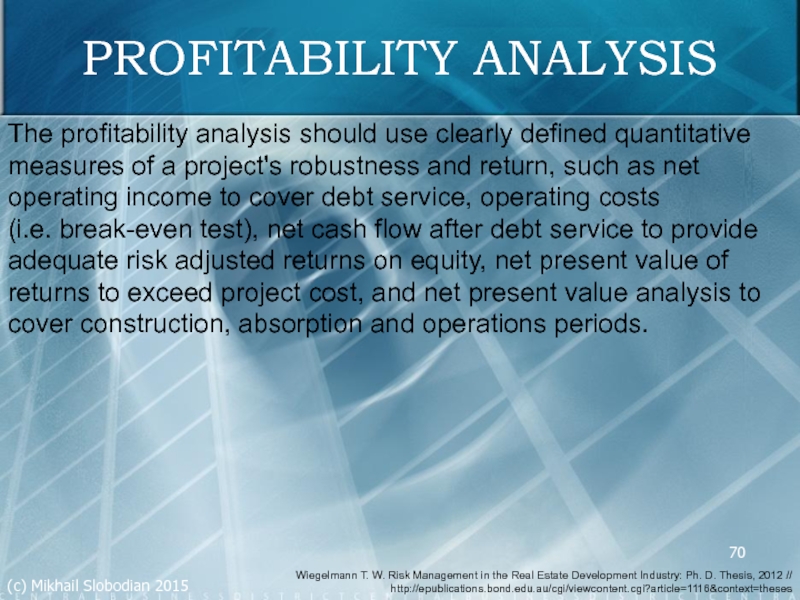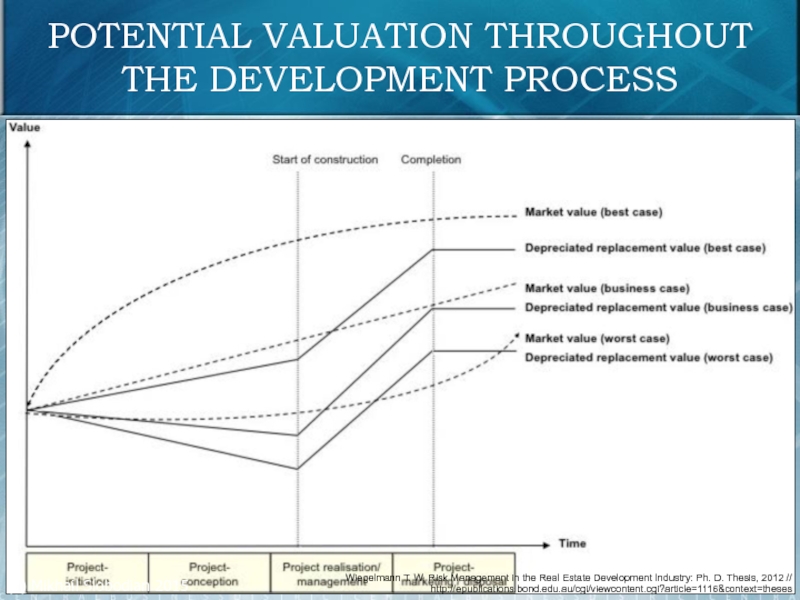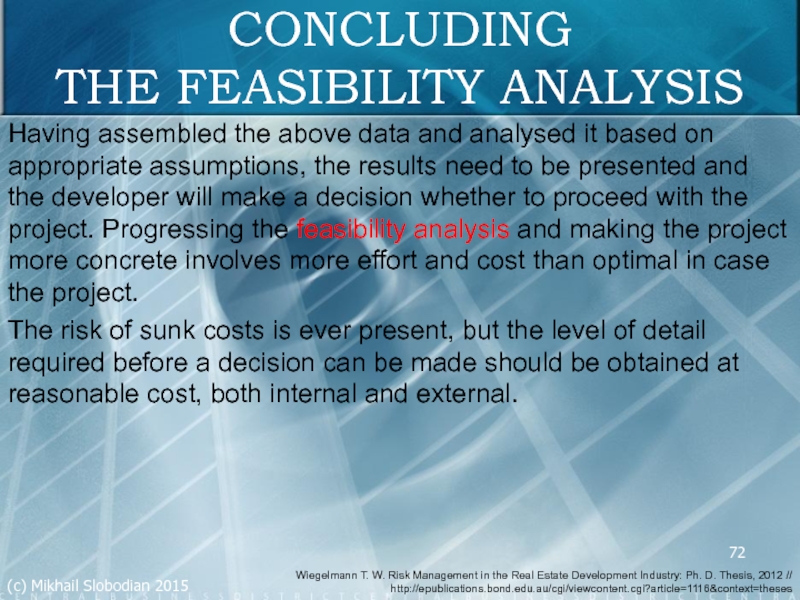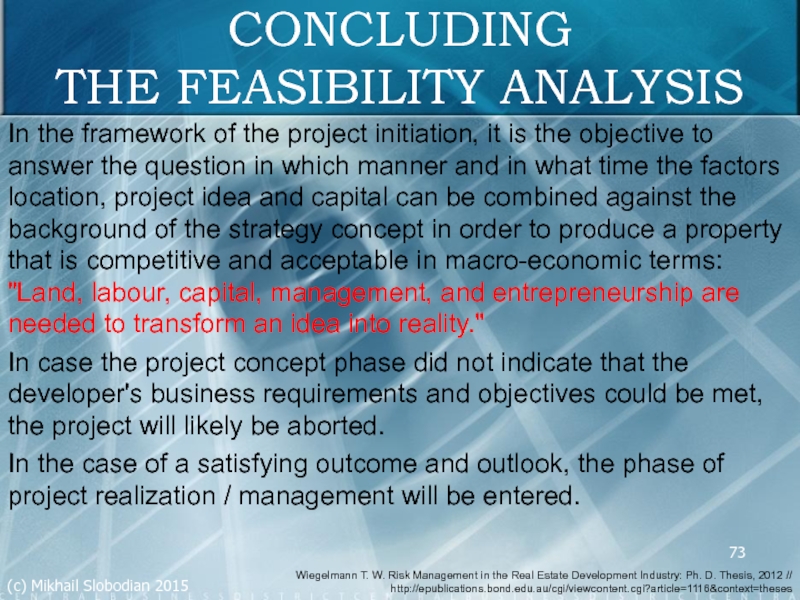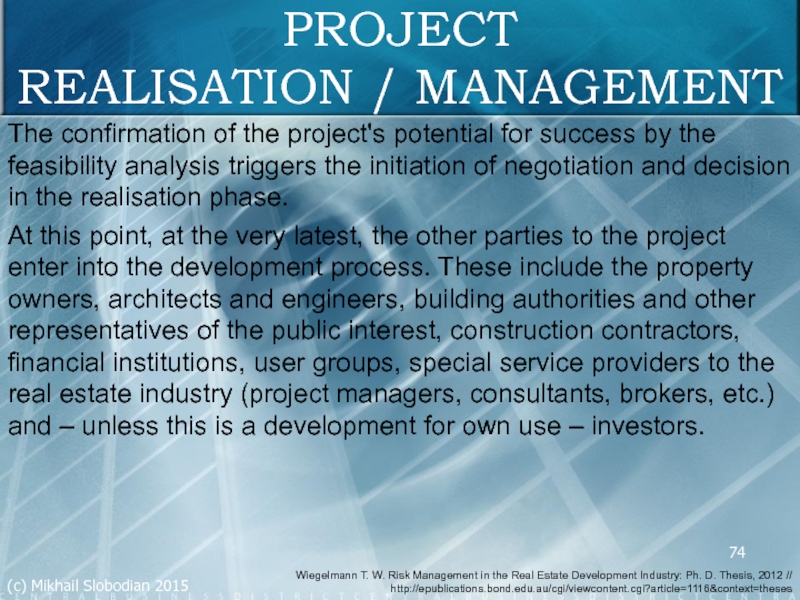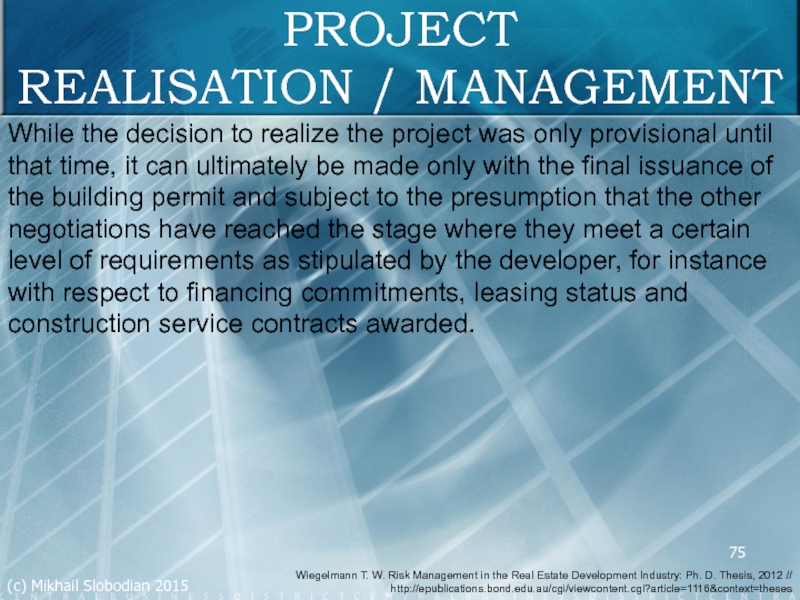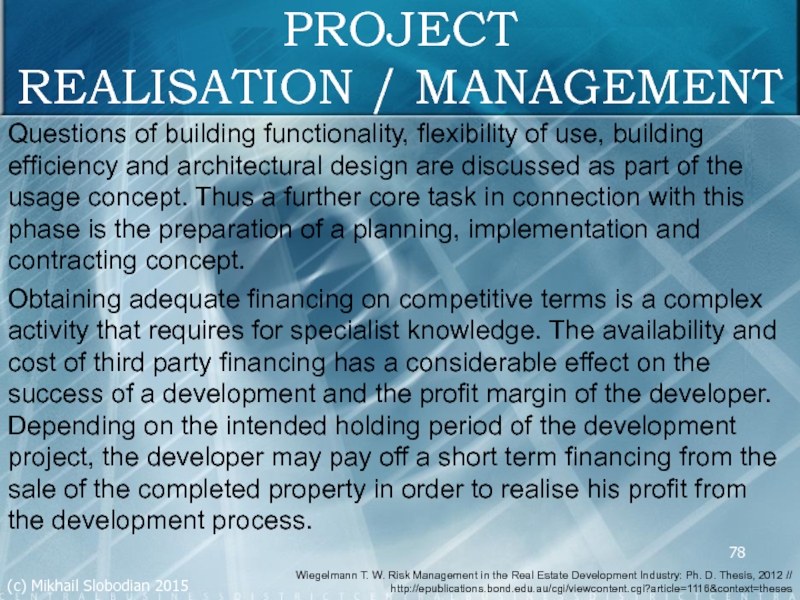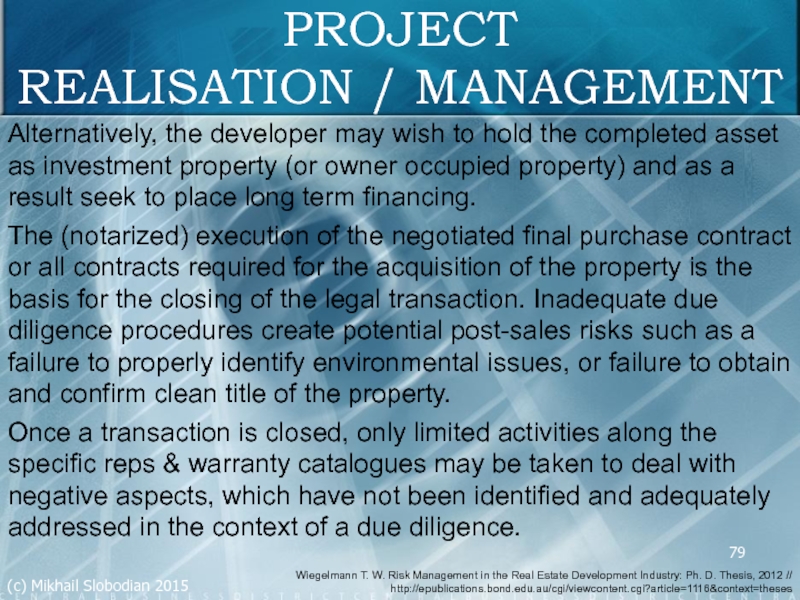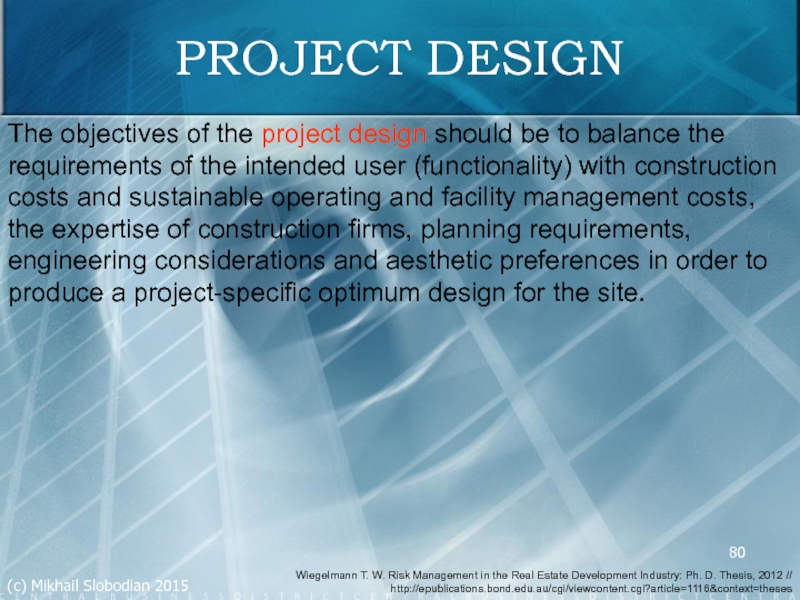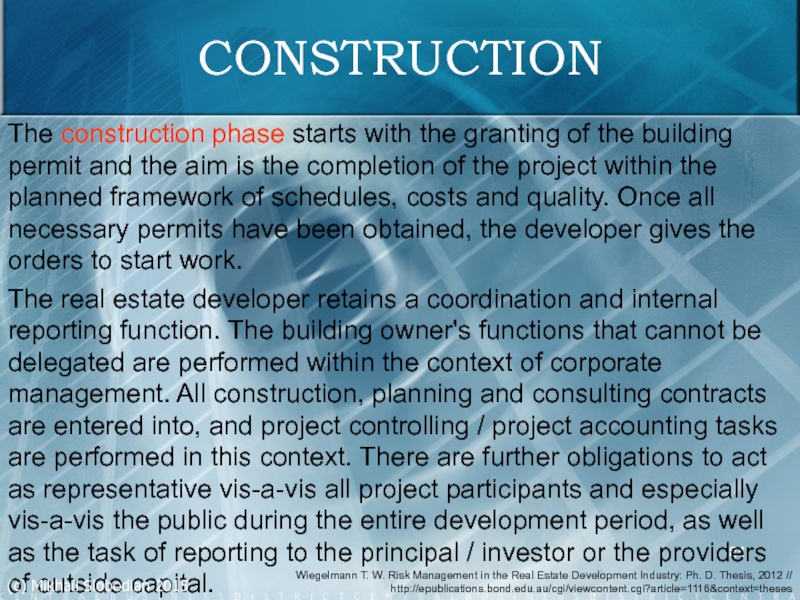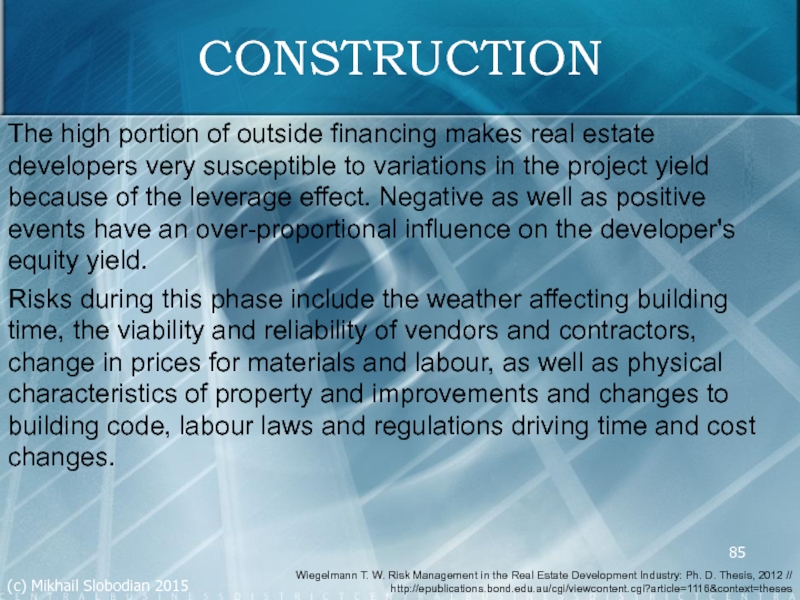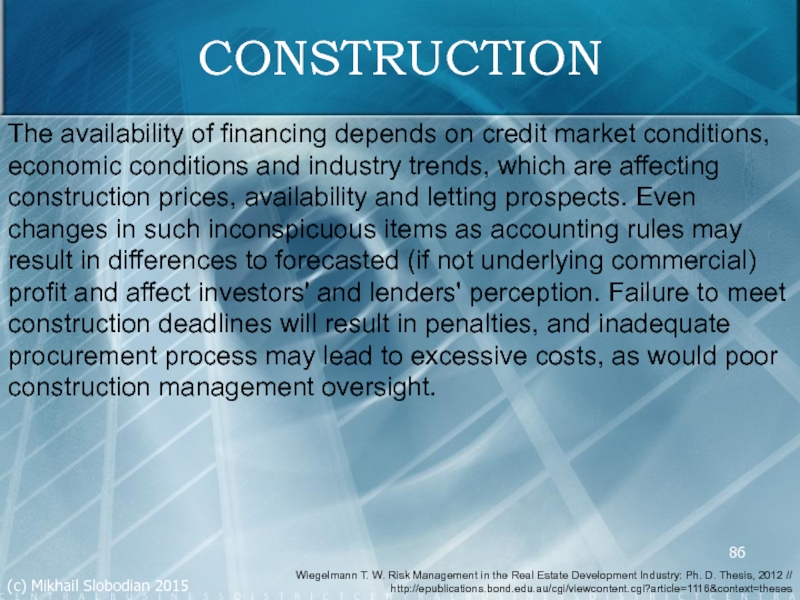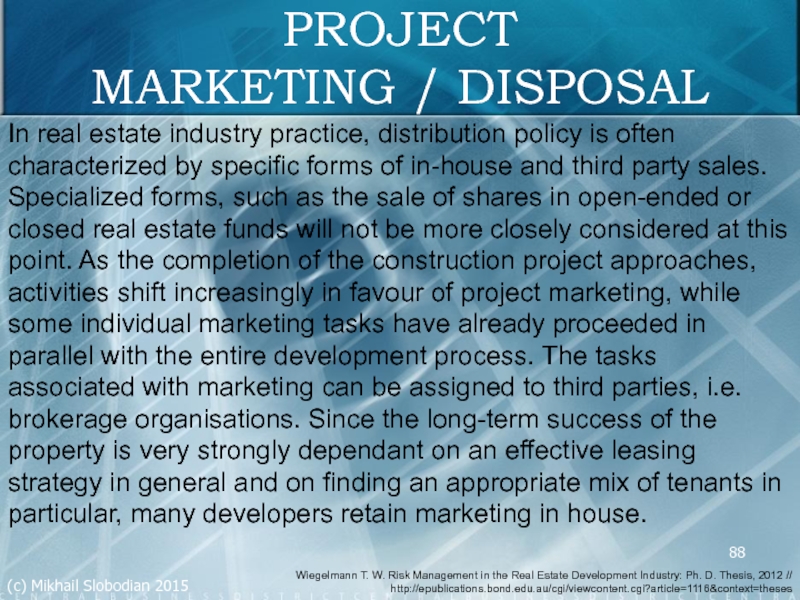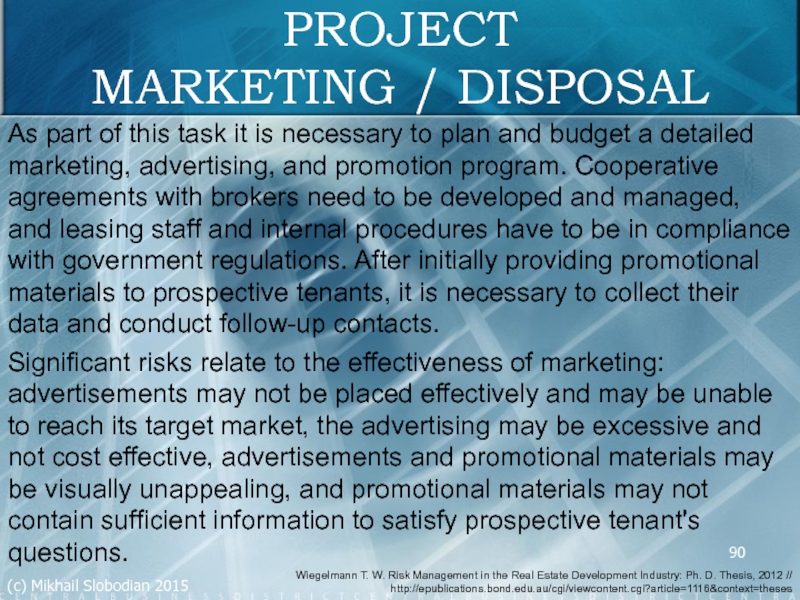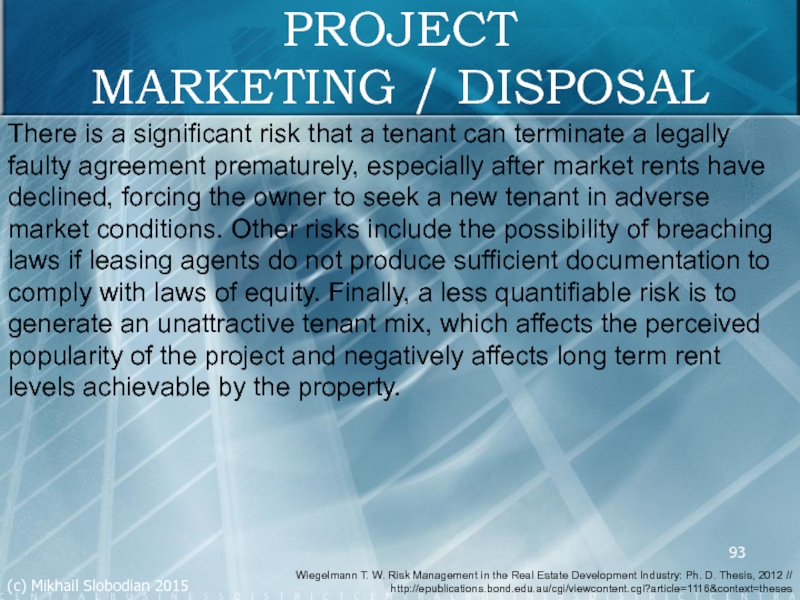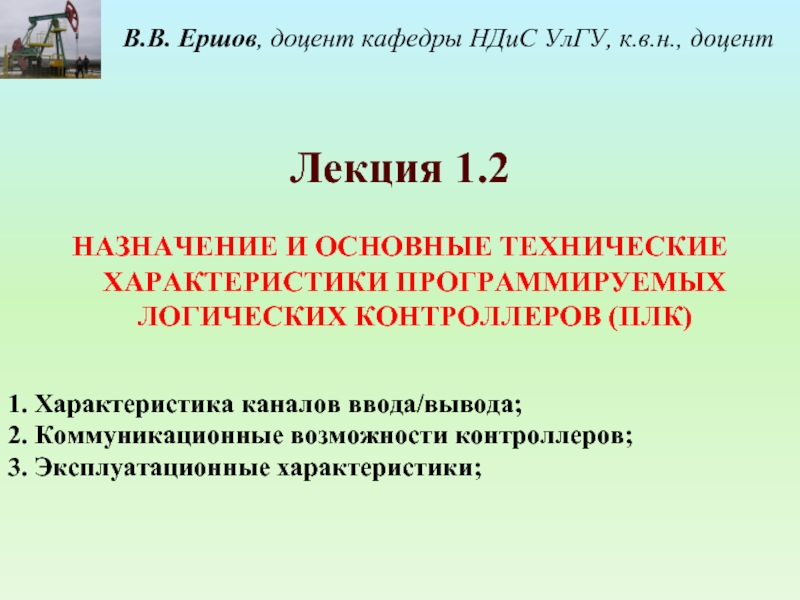- Главная
- Разное
- Дизайн
- Бизнес и предпринимательство
- Аналитика
- Образование
- Развлечения
- Красота и здоровье
- Финансы
- Государство
- Путешествия
- Спорт
- Недвижимость
- Армия
- Графика
- Культурология
- Еда и кулинария
- Лингвистика
- Английский язык
- Астрономия
- Алгебра
- Биология
- География
- Детские презентации
- Информатика
- История
- Литература
- Маркетинг
- Математика
- Медицина
- Менеджмент
- Музыка
- МХК
- Немецкий язык
- ОБЖ
- Обществознание
- Окружающий мир
- Педагогика
- Русский язык
- Технология
- Физика
- Философия
- Химия
- Шаблоны, картинки для презентаций
- Экология
- Экономика
- Юриспруденция
An introduction to risk management in real estate development презентация
Содержание
- 1. An introduction to risk management in real estate development
- 2. DEFINITION OF REAL ESTATE DEVELOPMENT The
- 3. DEFINITION OF REAL ESTATE DEVELOPMENT Real
- 4. DEFINITION OF REAL ESTATE DEVELOPMENT Development
- 5. THE PURPOSE OF REAL ESTATE DEVELOPMENT
- 6. THE PURPOSE OF REAL ESTATE DEVELOPMENT
- 7. THE PURPOSE OF REAL ESTATE DEVELOPMENT
- 8. THE PURPOSE OF REAL ESTATE DEVELOPMENT
- 9. THE PURPOSE OF REAL ESTATE DEVELOPMENT
- 10. THE PURPOSE OF REAL ESTATE DEVELOPMENT
- 11. RISKY NATURE OF REAL ESTATE DEVELOPMENT
- 12. Wiegelmann T. W. Risk Management in the
- 13. REGULATORY PRESSURE Regulatory and corporate governance
- 14. CAPITAL MARKETS PRESSURE The capital market
- 15. STAKEHOLDERS' PRESSURE Other stakeholders of real
- 16. REAL ESTATE AS A UNIQUE ASSET CLASS
- 17. REAL ESTATE AS A UNIQUE ASSET CLASS
- 18. REAL ESTATE AS A UNIQUE ASSET CLASS
- 19. REAL ESTATE AS A UNIQUE ASSET CLASS
- 20. SPECIFIC CHARACTERISTICS OF THE REAL ESTATE MARKET
- 21. SPECIFIC CHARACTERISTICS OF THE REAL ESTATE MARKET
- 22. SPECIFIC CHARACTERISTICS OF THE REAL ESTATE MARKET
- 23. SPECIFIC CHARACTERISTICS OF THE REAL ESTATE MARKET
- 24. TYPES OF REAL ESTATE DEVELOPERS There
- 25. TYPES OF REAL ESTATE DEVELOPERS Essentially,
- 26. TYPES OF REAL ESTATE DEVELOPERS
- 27. TYPES OF REAL ESTATE DEVELOPERS Trader-developers
- 28. TYPES OF REAL ESTATE DEVELOPERS Investor-developers
- 29. TYPES OF REAL ESTATE DEVELOPERS Investor-developers
- 30. TYPES OF REAL ESTATE DEVELOPERS Service
- 31. (c) Mikhail Slobodian 2015 TYPES OF REAL
- 32. TYPES OF REAL ESTATE DEVELOPERS With
- 33. TYPES OF REAL ESTATE DEVELOPERS In
- 34. TYPES OF REAL ESTATE DEVELOPERS Organisational
- 35. Wiegelmann T. W. Risk Management in the
- 36. STATE OF AFFAIRS IN REAL ESTATE INDUSTRY
- 37. OVERVIEW TO THE GENERIC REAL ESTATE DEVELOPMENT
- 38. GENERIC REAL ESTATE DEVELOPMENT PROCESS
- 39. GENERIC REAL ESTATE DEVELOPMENT PROJECT (c) Mikhail Slobodian 2015
- 40. PROJECT INITIATION The initiation phase commences
- 41. PROJECT INITIATION Accordingly, the starting situation
- 42. CONCEIVABLE STARTING-POINTS FOR A REAL ESTATE DEVELOPMENT
- 43. PROJECT INITIATION Accurate and pre-planned “timing”
- 44. PROJECT INITIATION Based on a positive
- 45. PROJECT INITIATION Option agreements or a
- 46. PROJECT CONCEPTION The conception phase starts
- 47. PROJECT CONCEPTION This is ultimately intended
- 48. PROJECT CONCEPTION The term “feasibility analysis”
- 49. STRUCTURE OF FEASIBILITY ANALYSIS
- 50. MARKET ANALYSIS The market analysis concerns
- 51. LOCATION ANALYSIS The analysis of the
- 52. PROJECT CONCEPT ANALYSIS The building or
- 53. COMPETITION ANALYSIS The three above aspects
- 54. RISK ANALYSIS While risks are present
- 55. RISK ANALYSIS The project-specific manoeuvrability, i.
- 56. RISK ANALYSIS Furthermore, although the overall
- 57. THE DEVELOPER'S DECREASING ABILITY TO INFLUENCE TOTAL
- 58. Wiegelmann T. W. Risk Management in the
Слайд 2DEFINITION OF
REAL ESTATE DEVELOPMENT
The views expressed in specialist literature regarding the
Development means the carrying out of building or other operations in, on, over or under land, or the making of any material change in the use of any buildings or other land. This definition reflects the functional characteristics of real estate development and continues to be widely used.
Real estate development is a process that involves changing or intensifying the use of land to produce buildings for occupation.
Wiegelmann T. W. Risk Management in the Real Estate Development Industry: Ph. D. Thesis, 2012 // http://epublications.bond.edu.au/cgi/viewcontent.cgi?article=1116&context=theses
(c) Mikhail Slobodian 2015
Слайд 3DEFINITION OF
REAL ESTATE DEVELOPMENT
Real estate is a triangle of space, money
The creation and management of space time units is termed real estate development. This definition primarily makes reference to the economic benefit derived from the space produced by the developer.
Wiegelmann T. W. Risk Management in the Real Estate Development Industry: Ph. D. Thesis, 2012 // http://epublications.bond.edu.au/cgi/viewcontent.cgi?article=1116&context=theses
(c) Mikhail Slobodian 2015
Слайд 4DEFINITION OF
REAL ESTATE DEVELOPMENT
Development is an idea that comes to fruition
Wiegelmann T. W. Risk Management in the Real Estate Development Industry: Ph. D. Thesis, 2012 // http://epublications.bond.edu.au/cgi/viewcontent.cgi?article=1116&context=theses
(c) Mikhail Slobodian 2015
Слайд 5THE PURPOSE OF
REAL ESTATE DEVELOPMENT
The purpose of real estate development is
The added value created by the developer does not result solely from the fact that a building is constructed on an undeveloped plot or that a condemned property is redeveloped, but may also be based on other measures of increasing the usage of the property and the productivity of space. This includes, in particular, the structural usage of currently unused space on a plot of land or within a property, as well as conversion / rebuilding measures, e.g. turning auxiliary space into rentable space.
Wiegelmann T. W. Risk Management in the Real Estate Development Industry: Ph. D. Thesis, 2012 // http://epublications.bond.edu.au/cgi/viewcontent.cgi?article=1116&context=theses
(c) Mikhail Slobodian 2015
Слайд 6THE PURPOSE OF
REAL ESTATE DEVELOPMENT
Generally, the priority goal of a developer
The developer's role is essentially one of supplying a stream of entrepreneurial services to the property market through both the identification and activation of market opportunities.
The real estate development industry assembles and applies the financial and physical resources to construct new built space in its role as a converter of financial capital into physical capital.
Wiegelmann T. W. Risk Management in the Real Estate Development Industry: Ph. D. Thesis, 2012 // http://epublications.bond.edu.au/cgi/viewcontent.cgi?article=1116&context=theses
(c) Mikhail Slobodian 2015
Слайд 7THE PURPOSE OF
REAL ESTATE DEVELOPMENT
To meet its objectives, a developer has
The investor's goal system arises from the classic investment objectives, namely return, preservation of value and liquidity.
Developers may be viewed as the risk-taking entrepreneurs who combine land, labour and capital to plan, manage and market facilities which they believe will provide services demanded by space users.
Wiegelmann T. W. Risk Management in the Real Estate Development Industry: Ph. D. Thesis, 2012 // http://epublications.bond.edu.au/cgi/viewcontent.cgi?article=1116&context=theses
(c) Mikhail Slobodian 2015
Слайд 8THE PURPOSE OF
REAL ESTATE DEVELOPMENT
Development is a complex process which entails
Real estate development as a highly synergistic and creative process in which physical ingredients are effectively combined with financial resources and professional skills, to create a built-environment that is economically sound, aesthetically pleasing and environmentally responsive. At its best, the development process is synergistic – that is, the ultimate combination of resources has a greater value than the sum of the individual parts.
Wiegelmann T. W. Risk Management in the Real Estate Development Industry: Ph. D. Thesis, 2012 // http://epublications.bond.edu.au/cgi/viewcontent.cgi?article=1116&context=theses
(c) Mikhail Slobodian 2015
Слайд 9THE PURPOSE OF
REAL ESTATE DEVELOPMENT
Real estate development is required to combine
Distinguishes between real estate development in the strict sense, which comprises the period from project initiation until the decision regarding the further procedure within the conceptual framework, and real estate development in the broader sense, which includes both the planning and construction phase and the usage phase of real estate.
Wiegelmann T. W. Risk Management in the Real Estate Development Industry: Ph. D. Thesis, 2012 // http://epublications.bond.edu.au/cgi/viewcontent.cgi?article=1116&context=theses
(c) Mikhail Slobodian 2015
Слайд 10THE PURPOSE OF
REAL ESTATE DEVELOPMENT
This conceptual understanding makes stronger reference to
Wiegelmann T. W. Risk Management in the Real Estate Development Industry: Ph. D. Thesis, 2012 // http://epublications.bond.edu.au/cgi/viewcontent.cgi?article=1116&context=theses
(c) Mikhail Slobodian 2015
Слайд 11RISKY NATURE OF
REAL ESTATE DEVELOPMENT
Real estate development is considered to be
As the creation of real estate products is in many cases speculative and therefore in anticipation of an unknown future demand, risk and uncertainty are key elements of real estate development.
The development business is to be regarded as highly cyclical and volatile asserts that real estate development is knowingly taking risk.
Real estate development is subject to a number of risk factors. Successful development, inter alia, depends on bringing the adequate real estate product to the market at the right time at the right price. The development profit depends on achieving all that while balancing costs against value.
Wiegelmann T. W. Risk Management in the Real Estate Development Industry: Ph. D. Thesis, 2012 // http://epublications.bond.edu.au/cgi/viewcontent.cgi?article=1116&context=theses
(c) Mikhail Slobodian 2015
Слайд 12Wiegelmann T. W. Risk Management in the Real Estate Development Industry:
(c) Mikhail Slobodian 2015
RISKY NATURE OF
REAL ESTATE DEVELOPMENT
Development is fixed both in time and space and involves relatively large amounts of capital. Furthermore, real estate development is a very complex and cross-disciplinary task as it typically demands a dedicated team including people with different skill sets and expertise and the co-ordination of a wide range of interrelated activities.
Local authorities, legal requirements, residents and neighbours are to be satisfied, design teams and contractors to be managed, time scales, costs and contingencies to be monitored and lenders and other stakeholders – especially prospective tenants and investors – to be satisfied. In addition, real estate developers are often faced with considerable changes in their environment and new challenges driven by the macro-economic, social, urban-planning, political-legal, regulatory, environmental and technological framework conditions.
However, in spite of the high risk factors, the real estate development industry lags behind other industries in its sophistication and application of risk identification, evaluation, mitigation and control, "developers are often criticised for not sufficiently understanding and analysing risk."
The banking and insurance sectors have long developed and employed sophisticated systems of risk management techniques and methods and the amount of academic research in these areas is too numerous to list. Their efficacy is of course debatable following the global financial crisis, although this is likely to have been due to a lack of diligent application of said techniques. Compliance with statutory requirements on risk factors is also well established in the fields of quality, environment and safety. Risks that remain undetected or are detected too late can trigger crises at project level or even at corporate level. Often irreversible damage has occurred or losses have been incurred by then. As a rule, minimal scope for action is left at this late stage and it is frequently no longer possible to achieve the necessary turnaround.
Слайд 13REGULATORY PRESSURE
Regulatory and corporate governance provisions are increasingly requiring greater awareness
The main thrust of regulation has been aimed at the board of directors, calling for more control and discipline towards effective and efficient operation, reliability of financial reporting as well as compliance with laws and regulation.
Wiegelmann T. W. Risk Management in the Real Estate Development Industry: Ph. D. Thesis, 2012 // http://epublications.bond.edu.au/cgi/viewcontent.cgi?article=1116&context=theses
(c) Mikhail Slobodian 2015
Слайд 14CAPITAL MARKETS PRESSURE
The capital market now also requires adequate corporate risk
Wiegelmann T. W. Risk Management in the Real Estate Development Industry: Ph. D. Thesis, 2012 // http://epublications.bond.edu.au/cgi/viewcontent.cgi?article=1116&context=theses
(c) Mikhail Slobodian 2015
Слайд 15STAKEHOLDERS' PRESSURE
Other stakeholders of real estate development organisations expect an effective
In communicating risk-specific aspects to key stakeholders, a significant objective for management is to assure them that adequate risk management strategies have been implemented.
Wiegelmann T. W. Risk Management in the Real Estate Development Industry: Ph. D. Thesis, 2012 // http://epublications.bond.edu.au/cgi/viewcontent.cgi?article=1116&context=theses
(c) Mikhail Slobodian 2015
Слайд 16REAL ESTATE AS
A UNIQUE ASSET CLASS
The most prominent characteristics of real
These factors have far-reaching economic, legal and factual implications. The geographic location alone frequently determines the most likely use as well as the physical and / or structural possibilities, and the value of real estate is largely determined by external factors such as the condition and the possible uses of adjacent properties as well as the infrastructural facilities provided by the public sector.
Wiegelmann T. W. Risk Management in the Real Estate Development Industry: Ph. D. Thesis, 2012 // http://epublications.bond.edu.au/cgi/viewcontent.cgi?article=1116&context=theses
(c) Mikhail Slobodian 2015
Слайд 17REAL ESTATE AS
A UNIQUE ASSET CLASS
Land cannot be reproduced, any structures
The heterogeneity results in sub-market risks as well as property and valuation risks. Heterogeneity leads to both scarcity and limited substitutability. The possible uses of real estate are largely determined by the combination of geographical location, structural conditions and legal parameters. Thus, real estate is characterised by both scarcity and limited substitutability.
Wiegelmann T. W. Risk Management in the Real Estate Development Industry: Ph. D. Thesis, 2012 // http://epublications.bond.edu.au/cgi/viewcontent.cgi?article=1116&context=theses
(c) Mikhail Slobodian 2015
Слайд 18REAL ESTATE AS
A UNIQUE ASSET CLASS
Real estate development is a highly
Furthermore, the construction of real estate and the acquisition of a completed property require a considerable investment. Against this background and also in view of the objective of maximising the return on equity, external funds are often necessary to cover capital needs as not all property developers are also property investors. As a result, the development industry and capital market are closely interrelated.
Wiegelmann T. W. Risk Management in the Real Estate Development Industry: Ph. D. Thesis, 2012 // http://epublications.bond.edu.au/cgi/viewcontent.cgi?article=1116&context=theses
(c) Mikhail Slobodian 2015
Слайд 19REAL ESTATE AS
A UNIQUE ASSET CLASS
Finally, real estate is also characterised
Wiegelmann T. W. Risk Management in the Real Estate Development Industry: Ph. D. Thesis, 2012 // http://epublications.bond.edu.au/cgi/viewcontent.cgi?article=1116&context=theses
(c) Mikhail Slobodian 2015
Слайд 20SPECIFIC CHARACTERISTICS OF THE REAL ESTATE MARKET
The real estate market is
The allocation of land is not generally left to unrestricted market forces, both by the state and in the interest of as well as for the protection of the common welfare. The state, for instance, exerts its influence through social and tax policy in the form of rent regulations or depreciation allowances, and more directly by setting planning policy frameworks.
Moreover, because of the particular characteristics of real estate as an economic asset, the real estate market deviates clearly from the ideal of a perfect market.
Wiegelmann T. W. Risk Management in the Real Estate Development Industry: Ph. D. Thesis, 2012 // http://epublications.bond.edu.au/cgi/viewcontent.cgi?article=1116&context=theses
(c) Mikhail Slobodian 2015
Слайд 21SPECIFIC CHARACTERISTICS OF THE REAL ESTATE MARKET
The most prominent characteristic in
Wiegelmann T. W. Risk Management in the Real Estate Development Industry: Ph. D. Thesis, 2012 // http://epublications.bond.edu.au/cgi/viewcontent.cgi?article=1116&context=theses
(c) Mikhail Slobodian 2015
Слайд 22SPECIFIC CHARACTERISTICS OF THE REAL ESTATE MARKET
Generally, the market participants only
Regular information bottlenecks and the limited individual possibilities of obtaining, processing and disseminating information interfere with the decisions of the market participants as well as communication between the individual market segments.
Wiegelmann T. W. Risk Management in the Real Estate Development Industry: Ph. D. Thesis, 2012 // http://epublications.bond.edu.au/cgi/viewcontent.cgi?article=1116&context=theses
(c) Mikhail Slobodian 2015
Слайд 23SPECIFIC CHARACTERISTICS OF THE REAL ESTATE MARKET
The cyclical nature of real
Wiegelmann T. W. Risk Management in the Real Estate Development Industry: Ph. D. Thesis, 2012 // http://epublications.bond.edu.au/cgi/viewcontent.cgi?article=1116&context=theses
(c) Mikhail Slobodian 2015
Слайд 24TYPES OF
REAL ESTATE DEVELOPERS
There are many types of developers and an
Developers may have an independent background but are also often affiliated to financial or construction mother organisations.
Developers may be classified by their strategic capital role, geographic scope, ownership structure, and product type.
These structural characteristics are expected to have an impact on the complexity of risks which would affect the organisation and therefore impinge on the risk management approach.
Wiegelmann T. W. Risk Management in the Real Estate Development Industry: Ph. D. Thesis, 2012 // http://epublications.bond.edu.au/cgi/viewcontent.cgi?article=1116&context=theses
(c) Mikhail Slobodian 2015
Слайд 25TYPES OF
REAL ESTATE DEVELOPERS
Essentially, real estate developers operate as either trader
Wiegelmann T. W. Risk Management in the Real Estate Development Industry: Ph. D. Thesis, 2012 // http://epublications.bond.edu.au/cgi/viewcontent.cgi?article=1116&context=theses
(c) Mikhail Slobodian 2015
Слайд 26TYPES OF
REAL ESTATE DEVELOPERS
Wiegelmann T. W. Risk Management in the Real
(c) Mikhail Slobodian 2015
Слайд 27TYPES OF
REAL ESTATE DEVELOPERS
Trader-developers typically assume the entire risk until completion
Wiegelmann T. W. Risk Management in the Real Estate Development Industry: Ph. D. Thesis, 2012 // http://epublications.bond.edu.au/cgi/viewcontent.cgi?article=1116&context=theses
(c) Mikhail Slobodian 2015
Слайд 28TYPES OF
REAL ESTATE DEVELOPERS
Investor-developers carry out projects to establish a portfolio
Thus investor-developers do – in addition to development profits – capitalise on capital appreciation.
Wiegelmann T. W. Risk Management in the Real Estate Development Industry: Ph. D. Thesis, 2012 // http://epublications.bond.edu.au/cgi/viewcontent.cgi?article=1116&context=theses
(c) Mikhail Slobodian 2015
Слайд 29TYPES OF
REAL ESTATE DEVELOPERS
Investor-developers and trader-developers share many characteristics. However, as
Trader-developers may evolve to a investor-developer profile over time, once profits from trading are available to be retained in completed real estate schemes for the own portfolio.
Wiegelmann T. W. Risk Management in the Real Estate Development Industry: Ph. D. Thesis, 2012 // http://epublications.bond.edu.au/cgi/viewcontent.cgi?article=1116&context=theses
(c) Mikhail Slobodian 2015
Слайд 30TYPES OF
REAL ESTATE DEVELOPERS
Service developers render specific real estate development services
Wiegelmann T. W. Risk Management in the Real Estate Development Industry: Ph. D. Thesis, 2012 // http://epublications.bond.edu.au/cgi/viewcontent.cgi?article=1116&context=theses
(c) Mikhail Slobodian 2015
Слайд 31(c) Mikhail Slobodian 2015
TYPES OF
REAL ESTATE DEVELOPERS
Financially, service developers commit themselves
Hybrid forms also exist, with their differences not being clearly distinguishable.
Wiegelmann T. W. Risk Management in the Real Estate Development Industry: Ph. D. Thesis, 2012 // http://epublications.bond.edu.au/cgi/viewcontent.cgi?article=1116&context=theses
Слайд 32TYPES OF
REAL ESTATE DEVELOPERS
With regards to the geographical focus of developer's
The product categories (residential, commercial, special use) may serve as another classification scheme.
With respect to the ownership structure, listed and unlisted development organisations may be differentiated.
Wiegelmann T. W. Risk Management in the Real Estate Development Industry: Ph. D. Thesis, 2012 // http://epublications.bond.edu.au/cgi/viewcontent.cgi?article=1116&context=theses
(c) Mikhail Slobodian 2015
Слайд 33TYPES OF
REAL ESTATE DEVELOPERS
In order to distinguish between different development projects,
Typically, high-volume developments are usually associated with longer development times, entailing greater risks and will likely have an impact on the risk management strategy. In addition to the investor, upon whose requirements and investment criteria a project should be structured, the project size must also take into consideration the working capital, expertise, capacities and resources of the real estate developer.
Wiegelmann T. W. Risk Management in the Real Estate Development Industry: Ph. D. Thesis, 2012 // http://epublications.bond.edu.au/cgi/viewcontent.cgi?article=1116&context=theses
(c) Mikhail Slobodian 2015
Слайд 34TYPES OF
REAL ESTATE DEVELOPERS
Organisational size could potentially act as a further
Wiegelmann T. W. Risk Management in the Real Estate Development Industry: Ph. D. Thesis, 2012 // http://epublications.bond.edu.au/cgi/viewcontent.cgi?article=1116&context=theses
(c) Mikhail Slobodian 2015
Слайд 35Wiegelmann T. W. Risk Management in the Real Estate Development Industry:
STATE OF AFFAIRS IN
REAL ESTATE INDUSTRY
The results and observations of the research have identified a lack of understanding in respect of risk management by real estate developers and have also distinguished weaknesses in addressing risk management issues:
the developers' approach towards the management of risks tends to be characterized by a lack of formalisation and coordination and largely rely on individual judgment and experience;
risk management is not regarded as a continuous and dynamic process and is often fragmented with only few development organisations having formal processes to align risk management with corporate strategy;
(c) Mikhail Slobodian 2015
Слайд 36STATE OF AFFAIRS IN
REAL ESTATE INDUSTRY
most real estate developers do not
many organisations have some measures of risk management activities but few can claim to have an enterprise wide risk management strategy;
demand for training and education is vital for a rigorous risk management practise.
Hence, various potential benefits could be obtained by development organizations through careful review of their existing risk management practices, which subsequently may also have a positive impact upon the wider economy:
Wiegelmann T. W. Risk Management in the Real Estate Development Industry: Ph. D. Thesis, 2012 // http://epublications.bond.edu.au/cgi/viewcontent.cgi?article=1116&context=theses
(c) Mikhail Slobodian 2015
Слайд 37OVERVIEW TO THE GENERIC REAL ESTATE DEVELOPMENT PROCESS
The real estate development
In the case of real estate development, the process starts with the three factors of location, project idea and capital and ends with the real estate object being ready for occupation.
Wiegelmann T. W. Risk Management in the Real Estate Development Industry: Ph. D. Thesis, 2012 // http://epublications.bond.edu.au/cgi/viewcontent.cgi?article=1116&context=theses
(c) Mikhail Slobodian 2015
Слайд 38GENERIC REAL ESTATE DEVELOPMENT PROCESS
Wiegelmann T. W. Risk Management in the
(c) Mikhail Slobodian 2015
Слайд 40PROJECT INITIATION
The initiation phase commences the development process.
A main expertise of
Creativity and drive are essential for a projects' success.
Generating ideas within the framework of project initiation can, in principle, be divided into a level of factual analysis and secondly a level of inspiration and vision.
Wiegelmann T. W. Risk Management in the Real Estate Development Industry: Ph. D. Thesis, 2012 // http://epublications.bond.edu.au/cgi/viewcontent.cgi?article=1116&context=theses
(c) Mikhail Slobodian 2015
Слайд 41PROJECT INITIATION
Accordingly, the starting situation for a development may either be:
an
a project idea for which a suitable location must be procured respectively capital in search;
the availability of capital seeking investment in a real estate project and thus a property / micro location and project idea / project concept.
Wiegelmann T. W. Risk Management in the Real Estate Development Industry: Ph. D. Thesis, 2012 // http://epublications.bond.edu.au/cgi/viewcontent.cgi?article=1116&context=theses
(c) Mikhail Slobodian 2015
Слайд 42CONCEIVABLE STARTING-POINTS FOR A REAL ESTATE DEVELOPMENT
Wiegelmann T. W. Risk Management
(c) Mikhail Slobodian 2015
Слайд 43PROJECT INITIATION
Accurate and pre-planned “timing” is a critical success factor in
Main activities within the project initiation phase are commencing specific market research to ascertain demand from potential users / tenants and potential investor profiles for the proposed development as well as preparing rudimentary development appraisals that will comprise the design, cost and program elements of the development. In case of a unsatisfying outcome of the concept and its initial economics, the project will likely not be pursued any further.
Wiegelmann T. W. Risk Management in the Real Estate Development Industry: Ph. D. Thesis, 2012 // http://epublications.bond.edu.au/cgi/viewcontent.cgi?article=1116&context=theses
(c) Mikhail Slobodian 2015
Слайд 44PROJECT INITIATION
Based on a positive evaluation, the next major step is
If the preliminary review is positive, the next step is to secure the required land in case the site is not already in the developer's possession or under exclusivity. In that case, a strategy for identifying and securing a site of suitable size, budget and location is to be elaborated. Often it is preferred by developers not to purchase the land at this stage but ensure exclusivity with the owner(s), given that a full feasibility analysis has not yet been completed.
Wiegelmann T. W. Risk Management in the Real Estate Development Industry: Ph. D. Thesis, 2012 // http://epublications.bond.edu.au/cgi/viewcontent.cgi?article=1116&context=theses
(c) Mikhail Slobodian 2015
Слайд 45PROJECT INITIATION
Option agreements or a purchase subject to conditions precedent are
Wiegelmann T. W. Risk Management in the Real Estate Development Industry: Ph. D. Thesis, 2012 // http://epublications.bond.edu.au/cgi/viewcontent.cgi?article=1116&context=theses
(c) Mikhail Slobodian 2015
Слайд 46PROJECT CONCEPTION
The conception phase starts with the project feasibility analysis and
Once the rough contours of the project have become visible in the preliminary acquisition review, what matters next is to outline the content of intellectual construct that was created in the initiation phase and to document it as a detailed project concept.
Wiegelmann T. W. Risk Management in the Real Estate Development Industry: Ph. D. Thesis, 2012 // http://epublications.bond.edu.au/cgi/viewcontent.cgi?article=1116&context=theses
(c) Mikhail Slobodian 2015
Слайд 47PROJECT CONCEPTION
This is ultimately intended to answer the question whether and
Real estate concepts comprise a great number of elements: function(s), location, size, branch (mix), target group(s), positioning, design, technical implementation / level of finishing, legal structure, marketing strategy, exploitation and management model.
Wiegelmann T. W. Risk Management in the Real Estate Development Industry: Ph. D. Thesis, 2012 // http://epublications.bond.edu.au/cgi/viewcontent.cgi?article=1116&context=theses
(c) Mikhail Slobodian 2015
Слайд 48PROJECT CONCEPTION
The term “feasibility analysis” has become accepted as a general
The goal of a feasibility study is to articulate a finding about the economic sustainability (feasibility) of the project under review.
A real estate project is “feasible” when the real estate analyst determines that there is a reasonable likelihood of satisfying explicit objectives when a selected course of action is tested for fit of a context of specific constraints and limited resources.
Prior to committing funds to a development project, a developer as well as his stakeholders and financing partners need a confirmation that market fundamentals will support the values assumed in the project appraisal.
Wiegelmann T. W. Risk Management in the Real Estate Development Industry: Ph. D. Thesis, 2012 // http://epublications.bond.edu.au/cgi/viewcontent.cgi?article=1116&context=theses
(c) Mikhail Slobodian 2015
Слайд 49STRUCTURE OF
FEASIBILITY ANALYSIS
Wiegelmann T. W. Risk Management in the Real Estate
(c) Mikhail Slobodian 2015
Слайд 50MARKET ANALYSIS
The market analysis concerns itself with the supply and demand
The main criteria to be considered are the requirements of potential users, how readily the project will be absorbed by the market, and subject to the effects of this absorption, the rent and property values applicable to the project.
The market analysis should be an objective view of the market, and allow the developer to understand the market dynamics and review, which to its own strengths can be utilised to take advantage of those dynamics.
Wiegelmann T. W. Risk Management in the Real Estate Development Industry: Ph. D. Thesis, 2012 // http://epublications.bond.edu.au/cgi/viewcontent.cgi?article=1116&context=theses
(c) Mikhail Slobodian 2015
Слайд 51LOCATION ANALYSIS
The analysis of the location should critically verify the findings
The objective must be to obtain verifiable data that can be analysed and presented in a manner to demonstrate to third parties the planned use of the land.
These analyses are concerned with the long term-effective characteristics of micro- and macro locations.
The location factors are both easily quantifiable "hard" criteria, as well as more “soft” criteria, which will always retain some level of subjectivity.
Wiegelmann T. W. Risk Management in the Real Estate Development Industry: Ph. D. Thesis, 2012 // http://epublications.bond.edu.au/cgi/viewcontent.cgi?article=1116&context=theses
(c) Mikhail Slobodian 2015
Слайд 52PROJECT CONCEPT ANALYSIS
The building or usage concept for the use of
The objective is to meet market demand while minimising cost (to build and operate) and maximising flexibility.
Wiegelmann T. W. Risk Management in the Real Estate Development Industry: Ph. D. Thesis, 2012 // http://epublications.bond.edu.au/cgi/viewcontent.cgi?article=1116&context=theses
(c) Mikhail Slobodian 2015
Слайд 53COMPETITION ANALYSIS
The three above aspects of market, location and usage concept
The first stage is the identification of appropriate benchmark properties.
The objectives are to meet client needs while differentiating the development as much as possible from competitors.
However, the weighting of criteria will always retain an element of subjectivity, which leads to residual risk.
Wiegelmann T. W. Risk Management in the Real Estate Development Industry: Ph. D. Thesis, 2012 // http://epublications.bond.edu.au/cgi/viewcontent.cgi?article=1116&context=theses
(c) Mikhail Slobodian 2015
Слайд 54RISK ANALYSIS
While risks are present at all stages of property development,
To some extent, the progress of a development project through the phases of development has a general impact on its risk levels.
In its early stages of the development process, the initiation phase is characterised by a high degree of uncertainty and, in particular, creative and complex search and analysis procedures. At the end of this phase, success potentials and competitive advantages of real estate projects are identified and the project fundamentals defined.
Wiegelmann T. W. Risk Management in the Real Estate Development Industry: Ph. D. Thesis, 2012 // http://epublications.bond.edu.au/cgi/viewcontent.cgi?article=1116&context=theses
(c) Mikhail Slobodian 2015
Слайд 55RISK ANALYSIS
The project-specific manoeuvrability, i. e. the scope for structuring architectural,
As a project progresses, types and extent of risks may change; new risks may emerge and existing risks may change in their importance. Of particular importance is the relationship between time and flexibility note: "As the process takes place, the developer's knowledge of the likely outcome increases but, at the same time, the room for manoeuvre decreases. Thus, while at the start of the process developers have maximum uncertainty and manoeuvrability, at the end they know all but can do nothing to change their product which has been manufactured on an essentially once and for all basis". Risk management should therefore be a continuing activity throughout duration of the project.
Wiegelmann T. W. Risk Management in the Real Estate Development Industry: Ph. D. Thesis, 2012 // http://epublications.bond.edu.au/cgi/viewcontent.cgi?article=1116&context=theses
(c) Mikhail Slobodian 2015
Слайд 56RISK ANALYSIS
Furthermore, although the overall complexity of the project decreases during
A high level of uncertainty occurs in the early stages of a project, which is also when business decisions of major impact for the success of a project are made. It is therefore imperative that potential risks are identified, assessed and allowed for at the outset of any project.
The developer should consider the risks to the project, attempt to quantify them within the feasibility analysis and potentially adjust the project so as to minimise them, where possible.
Wiegelmann T. W. Risk Management in the Real Estate Development Industry: Ph. D. Thesis, 2012 // http://epublications.bond.edu.au/cgi/viewcontent.cgi?article=1116&context=theses
(c) Mikhail Slobodian 2015
Слайд 57THE DEVELOPER'S DECREASING ABILITY TO INFLUENCE TOTAL COST OVER THE LIFE OF
Wiegelmann T. W. Risk Management in the Real Estate Development Industry: Ph. D. Thesis, 2012 // http://epublications.bond.edu.au/cgi/viewcontent.cgi?article=1116&context=theses
(c) Mikhail Slobodian 2015
Слайд 58Wiegelmann T. W. Risk Management in the Real Estate Development Industry:
RISK CATEGORIES AND RISK TYPES IN THE REAL ESTATE SECTOR
(c) Mikhail Slobodian 2015
